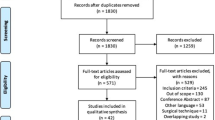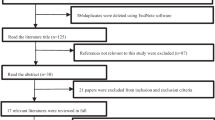Abstract
Background
Although minimally invasive surgical (MIS) approaches to the lumbar spine for posterior fusion are increasingly being utilized, the comparative outcomes of MIS and open posterior lumbar fusion remain unclear.
Questions/purposes
In this systematic review, we compared MIS and open transforaminal or posterior lumbar interbody fusion (TLIF/PLIF), specifically with respect to (1) surgical end points (including blood loss, surgical time, and fluoroscopy time), (2) clinical outcomes (Oswestry Disability Index [ODI] and VAS pain scores), and (3) adverse events.
Methods
We performed a systematic review of MEDLINE®, Embase, Web of Science, and Cochrane Library. Reference lists were manually searched. We included studies with 10 or more patients undergoing MIS compared to open TLIF/PLIF for degenerative lumbar disorders and reporting on surgical end points, clinical outcomes, or adverse events. Twenty-six studies of low- or very low-quality (GRADE protocol) met our inclusion criteria. No significant differences in patient demographics were identified between the cohorts (MIS: n = 856; open: n = 806).
Results
Equivalent operative times were observed between the cohorts, although patients undergoing MIS fusion tended to lose less blood, be exposed to more fluoroscopy, and leave the hospital sooner than their open counterparts. Patient-reported outcomes, including VAS pain scores and ODI values, were clinically equivalent between the MIS and open cohorts at 12 to 36 months postoperatively. Trends toward lower rates of surgical and medical adverse events were also identified in patients undergoing MIS procedures. However, in the absence of randomization, selection bias may have influenced these results in favor of MIS fusion.
Conclusions
Current evidence examining MIS versus open TLIF/PLIF is of low to very low quality and therefore highly biased. Results of this systematic review suggest equipoise in surgical and clinical outcomes with equivalent rates of intraoperative surgical complications and perhaps a slight decrease in perioperative medical complications. However, the quality of the current literature precludes firm conclusions regarding the comparative effectiveness of MIS versus open posterior lumbar fusion from being drawn and further higher-quality studies are critically required.

Similar content being viewed by others
References
Adogwa O, Parker SL, Bydon A, Cheng J, McGirt MJ. Comparative effectiveness of minimally invasive versus open transforaminal lumbar interbody fusion: 2-year assessment of narcotic use, return to work, disability and quality of life. J Spinal Disord Tech. 2011;24:479–484.
Allen RT, Garfin SR. The economics of minimally invasive spine surgery. Spine (Phila Pa 1976). 2010;35(26 suppl):S373–S382.
Bagan B, Patel N, Deutsch H, Harrop J, Sharan A, Vaccaro AR, Ratliff JK. Perioperative complications of minimally invasive surgery (MIS): comparison of MIS and open interbody fusion techniques. Surg Technol Int. 2008;17:281–286.
Brozek JL, Akl EA, Alonso-Coello P, Lang D, Jaeschke R, Williams JW, Phillips B, Lelgemann M, Lethaby A, Bousquet J, Guyatt GH, Schunemann HJ; GRADE Working Group. Grading quality of evidence and strength of recommendations in clinical practice guidelines. Part 1 of 3. An overview of the GRADE approach and grading quality of evidence about interventions. Allergy. 2009;64:669–677.
Carreon LY, Puno RM, Dimar JR 2nd, Glassman SD, Johnson JR. Perioperative complications of posterior lumbar decompression and arthrodesis in older adults. J Bone Joint Surg Am. 2003;85:2089–2092.
Cho KJ, Suk SI, Park SR, Kim JH, Kim SS, Choi SK, Lee KY, Lee SR. Complications in posterior fusion and instrumentation for degenerative lumbar scoliosis. Spine (Phila Pa 1976). 2007;32:2232–2237.
Chow A, Mayer EK, Dari AW, Athanasiou T. Patient-reported outcome measures: the importance of patient satisfaction in surgery. Surgery. 2009;146:435–443.
Deshpande PR, Rajan S, Sudeepthi BL, Abdul Nazir CP. Patient-reported outcomes: a new era in clinical research. Perspect Clin Res. 2011;2:137–144.
Deyo RA, Mirza SK, Martin BI, Kreuter W, Goodman DC, Jarvik JG. Trends, major medical complications, and charges associated with surgery for lumbar spinal stenosis in older adults. JAMA. 2010;303:1259–1265.
Dhall SS, Wang MY, Mummanenni PV. Clinical and radiographic comparison of mini-open transforaminal lumbar interbody fusion with open transforaminal lumbar interbody fusion in 42 patients with long-term follow-up. J Neurosurg Spine. 2008;9:560–565.
Fan S, Hu Z, Zhao F, Zhao X, Huang Y, Fang X. Multifidus muscle changes and clinical effects of one-level posterior lumbar interbody fusion: minimally invasive procedure versus conventional open approach. Eur Spine J. 2010;19:316–324.
Gahreman A, Ferch RD, Rao PJ, Bogduk N. Minimal access versus open posterior lumbar interbody fusion in the treatment of spondylolisthesis. Neurosurgery. 2010;66:296–304.
Garry R, Fountain J, Mason S, Napp V, Brown J, Hawe J, Clayton R, Abbott J, Phillips G, Whittaker M, Lilford R, Bridgman S. The eVALuate study: two parallel randomized trials, one comparing laparoscopic with abdominal hysterectomy, the other comparing laparoscopic with vaginal hysterectomy. BMJ. 2004;328:129–135.
Glassman SD, Carreon LY, Djurasovic M, Dimar JR, Johnson JR, Puno RM, Campbell MJ. Lumbar fusion outcomes stratified by specific diagnostic indication. Spine J. 2009;9:13–21.
Harris EB, Sayadipour A, Massey P, Duplantier NL, Anderson DG. Mini-open versus open decompression and fusion for lumbar degenerative spondylolisthesis with stenosis. Am J Orthop. 2011;40:E257–E261.
Isaacs RE, Podichetty VK, Santiago P, Sandhu FA, Spears J, Kelly K, Rice L, Fessler RG. Minimally invasive microendoscopy-assisted transforaminal lumbar interbody fusion with instrumentation. J Neurosurg Spine. 2005;3:98–105.
Kalanithi PS, Patil CG, Boakye M. National complication rates and disposition after posterior lumbar fusion for acquired spondylolisthesis. Spine (Phila Pa 1976). 2009;34:1963–1969.
Kotani Y, Abumi K, Ito M, Sudo H, Abe Y, Minami A. Mid-term clinical results of minimally invasive decompression and posterolateral fusion with percutaneous pedicle screws versus conventional approach for degenerative spondylolisthesis with spinal stenosis. Eur Spine J. 2012;21:1171–1177.
Lau D, Lee JG, Han SJ, Lu DC, Chou D. Complications and perioperative factors associated with learning the technique of minimally invasive transforaminal lumbar interbody fusion (TLIF). J Clin Neurosci. 2011;18:624–627.
Lee KH, Yue WM, Yeo W, Soeharno H, Tan SB. Clinical and radiological outcomes of open versus minimally invasive transforaminal lumbar interbody fusion. Eur Spine J. 2012;21:2265–2270.
Martin BI, Deyo RA, Mirza SK, Turner JA, Comstock BA, Hollingworth W, Sullivan SD. Expenditures and health status among adults with back and neck problems. JAMA. 2008;299:656–664.
Mobbs RJ, Sivabalan P, Li J. Minimally invasive surgery compared to open spinal fusion for the treatment of degenerative lumbar spine pathologies. J Clin Neurosci. 2012;19:829–835.
Moher D, Liberati A, Tetzlaff J, Altman DG. Methods of systematic reviews and meta-analysis. Preferred reporting items for systematic reviews and meta-analyses: The PRISMA statement. J Clin Epidemiol. 2009;62:1006–1012.
Ntoukas V, Muller A. Minimally invasive approach versus traditional open approach for one level posterior lumbar interbody fusion. Minim Invasive Neurosurg. 2010;53:21–24.
O’Leary TJ, Slutsky JR, Bernard MA. Comparative effectiveness research priorities at federal agencies: the view from the Department of Veterans Affairs, National Institute on Aging, and Agency for Healthcare Research and Quality. J Am Geriatr Soc. 2010;58:1187–1192.
Pace KT, Dyer SJ, Stewart RJ, Honey RJ, Poulin EC, Schiachta CM, Mamazza J. Health-related quality of life after laparoscopic and open nephrectomy. Surg Endoscopy. 2003;17:143–152.
Park Y, Ha JW. Comparison of one-level posterior lumbar interbody fusion performed with a minimally invasive approach or a traditional open approach. Spine (Phila Pa 1976). 2007;32:537–543.
Pelton MA, Phillips FM, Singh K. A comparison of perioperative costs and outcomes in patients with and without Workers’ compensation claims treated with MIS or open TLIF. Spine (Phila Pa 1976). 2012;37:1914–1919.
Peng CW, Yue WM, Poh SY, Yeo W, Tan SB. Clinical and radiological outcomes of minimally invasive versus open transforaminal lumbar interbody fusion. Spine (Phila Pa 1976). 2009;34:1385–1389.
Porter ME. What is value in health care? N Engl J Med. 2010;363:2477–2481.
Rampersaud YR, Gray R, Lewis SJ, Massicotte EM, Fehlings MG. Cost-utility analysis of posterior minimally invasive fusion compared with conventional open fusion for lumbar spondylolisthesis. SAS J. 2011;5:29–35.
Rihn JA, Berven S, Allen T, Phillips FM, Currier BL, Glassman SD, Nash DB, Mick C, Crockard A, Albert TJ. Defining value in spine care. Am J Med Qual. 2009;24(6 suppl):4S–14S.
Scheufler K, Dohmen H, Vougiokas VI. Percutaneous transforaminal lumbar interbody fusion for the treatment of degenerative lumbar instability. Neurosurgery. 2007;60(4 suppl 2):203–212.
Schizas C, Tzinieris N, Tsiridis E, Kosmopoulos V. Minimally invasive versus open transforaminal lumbar interbody fusion: evaluating initial experience. Int Orthop. 2009;33:1683–1688.
Starkweather AR, Witek-Janusek L, Nockels RP, Peterson J, Mathews HL. The multiple benefits of minimally invasive spinal surgery: results comparing transforaminal lumbar interbody fusion and posterior lumbar fusion. J Neurosci Nurs. 2008;40:32–39.
Stroup DF, Berlin JA, Morton SC, Olkin I, Williamson GD Rennie D, Moher D, Becker BJ, Sipe TA, Thacker SB. Meta-analysis of observational studies in epidemiology: a proposal for reporting. Meta-analysis of Observational Studies in Epidemiology (MOOSE) group. JAMA. 2000;283:2008–2012.
Thomsen K, Christensen FB, Eiskjaer SP, Hansen ES, Fruensgaard S, Bunger CE. 1997 Volvo Award winner in clinical studies. The effect of pedicle screw instrumentation on functional outcome and fusion rates in posterolateral lumbar spinal fusion: a prospective, randomized clinical study. Spine (Phila Pa 1976). 1997;22:2813–2822.
Topcu O. Karakayali F, Kuzu MA, Ozdemir S, Erverdi N, Eihan A, Aras N. Comparison of long-term quality of life after laparoscopic and open cholecystectomy. Surg Endoscopy. 2003:17:291–295.
Tsutsumimoto T, Shimogata M, Ohta H, Misawa H. Mini-open versus conventional open posterior lumbar interbody fusion for the treatment of lumbar degenerative spondylolisthesis. Spine (Phila Pa 1976). 2009;34:1923–1928.
Villavicencio AT, Burneikiene S, Roeca CM, Nelson EL, Mason A. Minimally invasive versus open transforaminal lumbar interbody fusion. Surg Neurol Int. 2010;1:12.
Wang H, Lu F, Jiang J, Ma X, Xiz X, Wang L. Minimally invasive lumbar interbody fusion via MAST Quadrant retractor versus open surgery: a prospective randomized clinical trial. Chin Med J. 2011;124:3868–3874.
Wang J, Zhou Y, Feng Zhang Z, Qing Li C, Jie Zheng W, Liu J. Comparison of clinical outcome in overweight or obese patients after minimally invasive versus open transforaminal lumbar interbody fusion. J Spinal Disord Tech. 2012 May 17 [Epub ahead of print].
Wang J, Zhou Y, Zhang ZF, Li CQ, Zheng WJ, Liu J. Comparison of one-level minimally invasive and open transforaminal lumbar interbody fusion in degenerative and isthmic spondylolisthesis grades 1 and 2. Eur Spine J. 2010;19:1780–1784.
Wang J, Zhou Y, Zhang ZF, Li CQ, Zheng WJ, Liu J. Minimally invasive or open transforaminal lumbar interbody fusion as revision surgery for patients previously treated by open discectomy and decompression of the lumbar spine. Eur Spine J. 2011;20:623–628.
Wang MY, Cummock MD, Yu Y, Trivedi RA. An analysis of the differences in the acute hospitalization charges following minimally invasive versus open posterior lumbar interbody fusion. J Neurosurg Spine. 2010;12:694–699.
Weinstein JN, Lurie JD, Tosteson TD, Zhao W, Blood EA, Tosteson ANA, Birkmeyer N, Herkowitz H, Longley M, Lenke L, Emery S, Hu S. Surgical compared with nonoperative treatment for lumbar degenerative spondylolisthesis: four-year results in the Spine Patient Outcomes Research Trial (SPORT) randomized and observational cohorts. J Bone Joint Surg Am. 2009;91:1295–1304.
Acknowledgments
We thank Dr. Dorin Rabin and Dr. Sooyong Chua for their assistance with a preliminary review of the literature and Ms. Oma Persaud MSc for her assistance with the electronic literature search.
Author information
Authors and Affiliations
Corresponding author
Additional information
One of the authors (YRR) certifies that he or she, or a member of his or her immediate family, has received or may receive payments or benefits, during the study period, an amount of USD 10,000 to USD 100,000, US from Medtronic, Inc (Memphis, TN, USA).
All ICMJE Conflict of Interest Forms for authors and Clinical Orthopaedics and Related Research editors and board members are on file with the publication and can be viewed on request.
Electronic supplementary material
Below is the link to the electronic supplementary material.
About this article
Cite this article
Goldstein, C.L., Macwan, K., Sundararajan, K. et al. Comparative Outcomes of Minimally Invasive Surgery for Posterior Lumbar Fusion: A Systematic Review. Clin Orthop Relat Res 472, 1727–1737 (2014). https://doi.org/10.1007/s11999-014-3465-5
Published:
Issue Date:
DOI: https://doi.org/10.1007/s11999-014-3465-5




